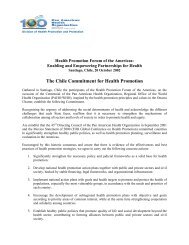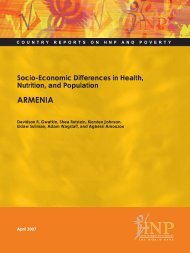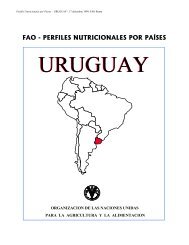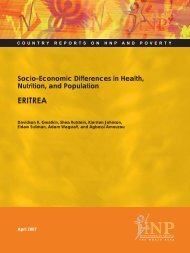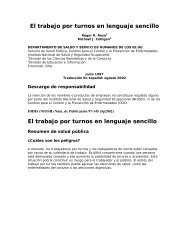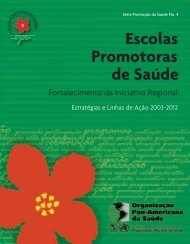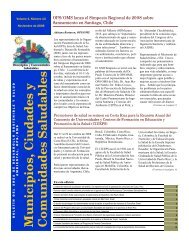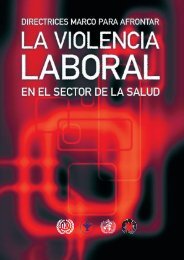Guidelines for drinking-water quality. Volume 1 - BVSDE
Guidelines for drinking-water quality. Volume 1 - BVSDE
Guidelines for drinking-water quality. Volume 1 - BVSDE
Create successful ePaper yourself
Turn your PDF publications into a flip-book with our unique Google optimized e-Paper software.
provisional guideline value until additional in<strong>for</strong>mation becomes available and chromium can be<br />
re-evaluated.<br />
Copper<br />
Copper levels in <strong>drinking</strong>-<strong>water</strong> are usually low at only a few micrograms per litre, but copper<br />
plumbing may result in greatly increased concentrations. Concentrations can reach several<br />
milligrams per litre following a period of stagnation in pipes.<br />
Copper is an essential element, and the intake from food is normally 1-3 mg/day. In adults, the<br />
absorption and retention rates of copper depend on the daily intake; as a consequence, copper<br />
overload is unlikely. Acute gastric irritation may be observed in some individuals at concentrations<br />
in <strong>drinking</strong>-<strong>water</strong> above 3 mg/litre. In adults with hepatolenticular degeneration, the copper<br />
regulatory mechanism is defective, and long-term ingestion can give rise to liver cirrhosis.<br />
Copper metabolism in infants, unlike that in adults, is not well developed, and the liver of the<br />
newborn infant contains over 90% of the body burden, with much higher levels than in adults.<br />
Since 1984, there has been some concern regarding the possible involvement of copper from<br />
<strong>drinking</strong>-<strong>water</strong> in early childhood liver cirrhosis in bottle-fed infants, although this has not been<br />
confirmed.<br />
In 1982, JECFA proposed a provisional maximum tolerable daily intake (PMTDI) of 0.5 mg/kg of<br />
body weight, based on a rather old study in dogs. With an allocation of 10% of the PMTDI to<br />
<strong>drinking</strong>-<strong>water</strong>, a provisional health-based guideline value of 2 mg/litre (rounded figure) is<br />
calculated. This study did not take into account the differences in copper metabolism in the<br />
neonate. However, a concentration of 2 mg/litre should also contain a sufficient margin of safety<br />
<strong>for</strong> bottle-fed infants, because their copper intake from other sources is usually low.<br />
In view of the remaining uncertainties regarding copper toxicity in humans, the guideline value is<br />
considered provisional. Copper can give rise to taste problems.<br />
Cyanide<br />
The acute toxicity of cyanides is high. Cyanides can be found in some foods, particularly in some<br />
developing countries, and they are occasionally found in <strong>drinking</strong>-<strong>water</strong>, primarily as a<br />
consequence of industrial contamination.<br />
Effects on the thyroid and particularly the nervous system were observed in some populations as<br />
a consequence of the long-term consumption of inadequately processed cassava containing high<br />
levels of cyanide. This problem seems to have decreased significantly in the West African<br />
populations in which it was widely reported, following a change in processing and a general<br />
improvement in nutritional status.<br />
There are a very limited number of toxicological studies suitable <strong>for</strong> use in deriving a guideline<br />
value. There is, however, some indication in the literature that pigs may be more sensitive than<br />
rats. There is only one study available in which a clear effect level was observed, at 1.2 mg/kg of<br />
body weight per day, in pigs exposed <strong>for</strong> 6 months. The effects observed were in behavioural<br />
patterns and serum biochemistry.<br />
Using the LOAEL from this study and applying an uncertainty factor of 100 to reflect inter- and<br />
intraspecies variation (no additional factor <strong>for</strong> a LOAEL was considered necessary because of<br />
doubts over the biological significance of the observed changes), a TDI of 12 µg/kg of body<br />
weight was calculated.<br />
An allocation of 20% of the TDI to <strong>drinking</strong>-<strong>water</strong> was made because exposure to cyanide from<br />
other sources is normally small and because exposure from <strong>water</strong> is only intermittent. This results




